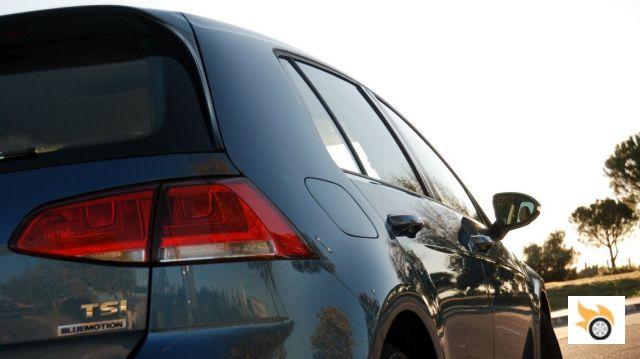One of the Golf Vs I had was the Bluemotion 1.9 TDI, which was rated at 4.5 l/100 km and allowed me to break the psychological barrier of 1,000 km without having to refuel. This one has the same rating, but you know that the figures associated with three-cylinder petrol engines are as reliable as "I don't sleep with anyone on the first date". I'll give you a little spoiler: the Golf 1.0 TSI is not that I liked it, it's that I loved it. I'd buy this three-cylinder. I'm writing this without having drunk or taken drugs.
Let's get to know this model, which is the most austere petrol Golf in history, and a healthy contender against the 1.6 TDI Bluemotion. I won't say it's eco-friendly because there's the e-Golf (pure electric), the Golf TGI (natural gas) and the Golf GTE (plug-in hybrid), and they pollute less than this one. If it had the particulate filter as standard, I'd recommend it with my eyes closed, and I'm well aware that it's more expensive than most of its C-segment alternatives.
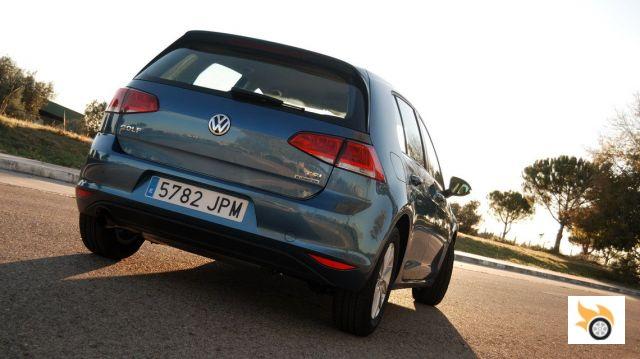
Design
The Volkswagen Golf has a very continuist image and that's the way it's going to stay. The brand doesn't want to experiment. It has been the most popular European compact for many years, is in its seventh generation, and has dazzled most Europeans in the C-segment. The Golf's sales figures are so high that it is considered amortized in less time than normal, so updates can come sooner.
It's the first Golf with MQB platform. Although it is larger than the previous model, it has increased wheelbase and track width and weighs up to 100 kg less. The platform is optimized to work with multiple engine types, and it remains - with no rival in sight - the compact with the most powertrain options. Its design has multiple variants, such as the R Line, Sportsvan (minivan), Variant (family), also has three-door version for the same price ... only lacks the convertible. It had it in the previous generation, but it is a very bad segment of its own.
The Bluemotion has some differences compared to any other Golf with the same bodywork. The front grille is partially covered, the suspension is lowered by 15mm ("sporty" suspension), it has a body-coloured rear spoiler and standard 15″ alloy wheels (16″ optional). A few logos identify it as the most austere Golf in its range, Bluemotion. That designation appeared back in the days when you could still believe that Volkswagen always played fair....
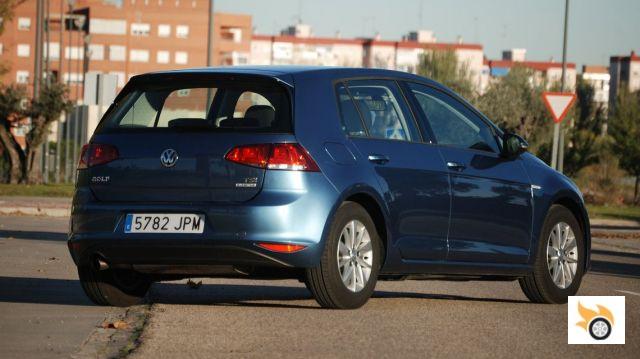
The fog lights, daytime running lights and front light clusters are halogen lights, which, by the way, do not illuminate badly at all. More than one will miss that it has a front camera, and it doesn't, so as standard it doesn't have any active safety technology based on this principle. The fog lights come as standard as part of the launch package, which is still valid, which also includes the front centre armrest.
Cx is 0.28, better than the average of its siblings (0.29).
In this version, aerodynamic efficiency has been prioritized a little more to consume less. Not only that, it is able to beat the 200 km / h with 115 hp power. The variable-opening lower grille has a dual function: it improves the engine's thermal management and prevents the engine from receiving more air than it needs, thus also reducing aerodynamic consumption. When the engine needs more cooling, the dampers let air through. We'll see later that this system has benefits for everyday use.
The standard wheels are designed to reduce aerodynamic drag, and although the profile is very large, they don't look ridiculous. They are 195/65 R15, have the advantage of being very economical to replace, and it is much more difficult to damage the rims when merging with the curb when parking. The exhaust outlet is fully visible. More than one will appreciate that it doesn't have parking sensors. The Bluemotion is a bit more limited in terms of equipment, and the list of possible extras is very limited to contain the weight.
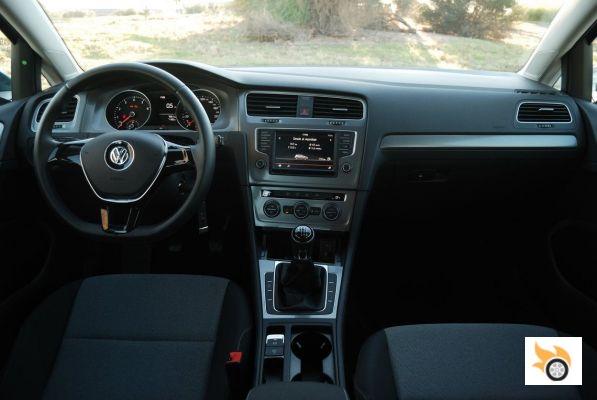
Cabin
One thing is clear, the Golf is an expensive car, but it has its justification. Not only does it charge for the badge, it has quality details that are very rare in the C-segment, and are more typical of models classified as Premium. The truth is that the Golf can say without hesitation that it rubs shoulders with the best cars in its category, and I say this without being suspected of being pro-GVW (although this depends on how everyone stands up when they read me).
I'm talking about details like having storage compartments that are either rubber lined or upholstered. I'm talking about brilliant soundproofing. I'm talking about the feel of all the controls, I just have to complain because I couldn't find any damn way to quickly adjust the dashboard illumination, and oh, I forgot, it seemed a bit too Polo to me. The quality is noticeable in small details, and roughly speaking, I think it's worth paying more for a better interior, but that's up to each person's pocket. There are hardly any hard plastic surfaces to the touch.
All the seats are comfortable and spacious, even the central rear seat can be used by people who don't suffer from anorexia or who are over 10 years old and have a wasp waist, although they will have to open their legs a bit because of the central tunnel. Sitting in the back, a guy of almost two meters can go more comfortable than in other compacts. One of the advantages of its design is that the C-pillar is very present and hardly falls, so it has very good habitability. The rear seats even have air vents for the torso, although the climate control is not a triple zone system.
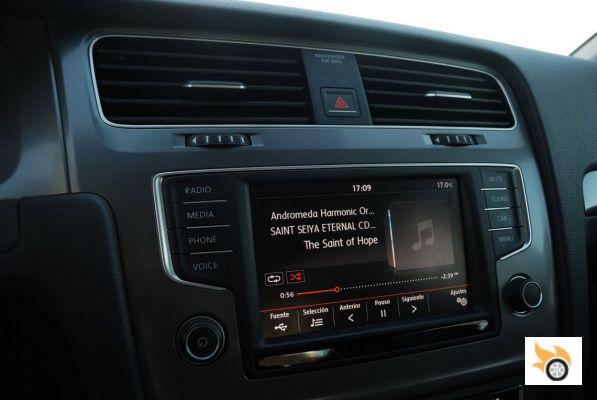
The Golf Bluemotion is based on the Golf Edition, which is the base model. Several years ago when we talked about an entry-level Golf it was a car that was as bald as a construction worker's back in Dubai. If this is the basic model, then good for it, I don't see any cheap car details anywhere. I do find it objectionable that the standard steering wheel doesn't have buttons to control the multimedia system or the mobile phone. The triple on-board computer (from start, from manual initialization and from refueling) is operated with two buttons on the right lever, the speed control with the left lever.
The central screen of the dashboard is not the most basic, it is the intermediate one, with 6.5 inches and gesture recognition to hide or show the menus. In the new Golf this has changed a bit. It's not very big, but it fulfills its function perfectly and convinced me in general. Maybe it should be located higher, like in the latest models, but it was released in 2013. The new version has bigger screens but they are not placed on top at all. It has advanced connectivity with newly manufactured Android phones and iPhones, and supports apps.
The parking brake is electric, but curiously has no engine start button, it is by turning the key. Opening the glove box you'll find a CD player, SD card reader, coin slots, lighting, cold air outlet and full upholstery. And no, it doesn't go down in one fell swoop. It also has a left side glovebox for the driver, central box, another hole where the ashtray would go before (ideal for mobile phones), etc.. The feel of the lids is worthy of much more expensive cars. In these things the price goes up...
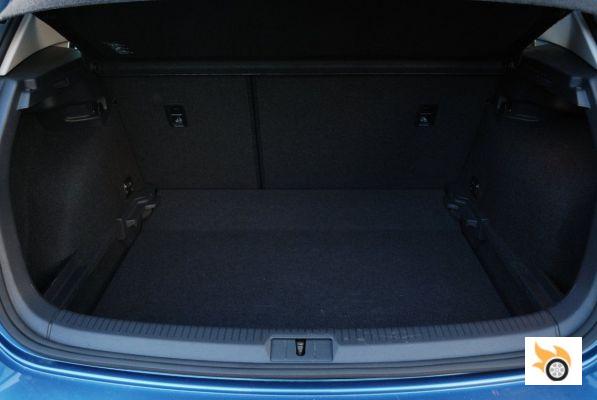
It is surprising the level of soundproofing that has, for starters the engine can practically pass for a four-cylinder, although the melody is different. The wheels sound little, the aerodynamic noise too (even above the legality), there is no tingling in the steering wheel typical of the three-cylinder, nor does the gear lever vibrates. In terms of insulation, Volkswagen's engineers have to be given an A+. In addition, the stereo sounds very good for not having any speaker blares.
One of the advantages of the good thermal management of the engine is that the heating works quickly, and I really appreciate that as I live in an area where it's very cold in the mornings. I must also highlight the high comfort of the suspension, I don't notice at all that it is lowered compared to the standard one. I have to say that the standard suspension of the Golf will seem very bourgeois to drivers with dynamic tastes. The size of the wheels also contributes to the feeling of isolation, few compacts use such large profiles anymore.
As for the boot, another advantage of the Golf's "boring" design is that the load opening is only 64 cm above the floor and is very spacious, which is noticeable when loading bulky objects. It has two floor heights, and has a position where the floor can be raised without the lid falling down. The capacity is 380 liters, very usable by the regular shapes of the compartment, but there are competitors that equal or exceed 400 liters. It has a well-disguised anti-puncture kit, and the triangles are not in the way as they are integrated in the tailgate itself. If the seats are folded down, something that does not require force, it almost forms a flat surface with the bottom in its raised position.
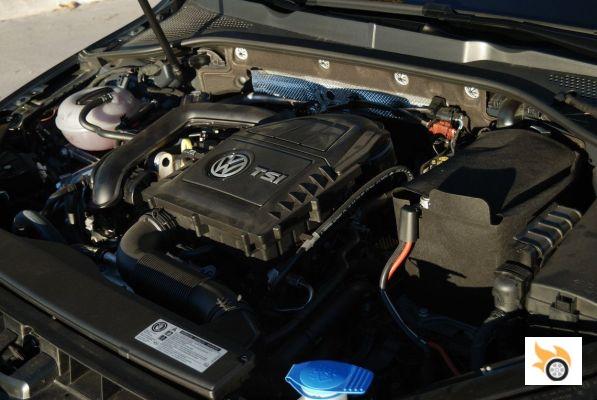
Technology
The crux of the Golf Bluemotion is the 1.0 TSI three-cylinder engine, which more than one reader considers to be an engine worthy of a motorcycle. Yes, there are many engines like this on the market, but the 200 Nm of specific torque per litre is surprising, a figure well above the average of all its three-cylinder competitors. This engine is very deceptive, it's a little more than the turbo engine in the Up! The naturally aspirated version in the Polo already gave a very good result with 75 hp. This one is even better. The non-Bluemotion gives 110 hp.
The first and second are shorter than in the 1.2 TSI.
It combines direct petrol injection with a Borgwarner turbocharger. This duo has obvious advantages in terms of response, fuel economy and refinement, but it has the problem that it generates fine particles - carcinogens - in a big way. If it had the FAP, I would find it possibly the best three-cylinder on the market, and I liked Opel's 1.0 SIDI a lot. And how do I say this, knowing that I hate these engines in expensive cars?
Volkswagen engineers have sweetened its behaviour to such a degree, that if nobody tells us it's a three-cylinder, and they cover our ears, we wouldn't notice it. It doesn't have a counter-rotating shaft to neutralize the inevitable vibrations of these engines. It does have several counterweights on the crankshaft and at the ends, so it's practically a balanced engine, like a four-cylinder. I only noticed a noticeable vibration between 1,500 and 2,000 RPM, with full throttle. Above 2,000 RPM I forget I'm driving a three-cylinder.
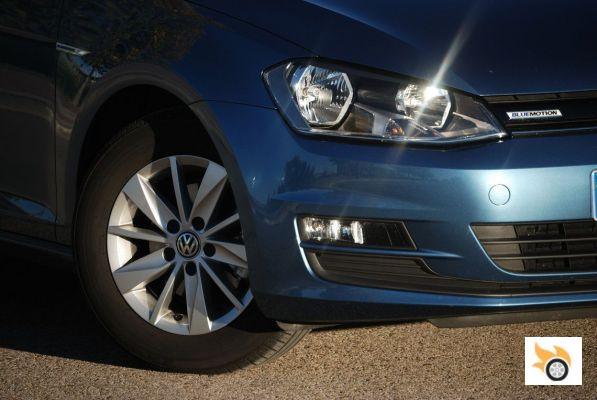
Another of this engine's secrets is its sophisticated cooling circuit, which makes very efficient use of the gasoline's energy: the engine heats up quickly to a stable level, but wastes less gasoline. Volkswagen doesn't boast about the thermal efficiency of this engine, when Toyota and Hyundai boast about reaching 40%. I'll tell you one thing, I don't remember driving any C-segment car that wastes less fuel without the help of an electric motor.
And that's because the 1.0 TSI doesn't have KERS or anything else. It has an alternator that disengages during acceleration, energy recovery during braking and Stop&Start, but that's not cutting-edge technology. It weighs 10 kg less than the infamous 1.2 TSI engine (105 hp version), which I consider to be one of the worst petrol engines Volkswagen has ever made after the hated 1.6 8-valve. This engine uses less gas, goes further, is more compact, has more "balls" (more torque)... I don't miss anything from the 1.2 TSI of the same power. Normally I would tell you that I prefer the four-cylinder. Not this time.
Like the underpowered Golfs, the rear suspension is torsion bar, and for what you're going to ask of this car, I don't find it at all objectionable. It doesn't need multi-link. It is criticized that there is no DSG version for the Spanish market, but I loved the six-speed manual gearbox. In a Toyota Auris Hybrid you have to give up the clutch and the manual gearbox, in this one it's the other way around. Volkswagen says you don't have to sacrifice anything to drive this car. I'll swallow it up to the gills and esophagus.
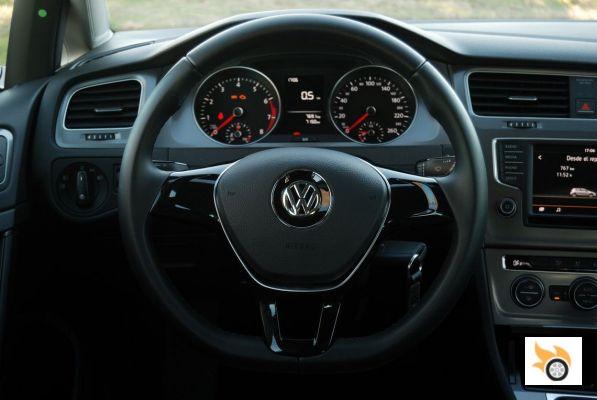
Driving
I know that a 115bhp model isn't the most piston-powered thing in the world, and in this case, it's certainly not. As a car to use every day, to do the usual kilometres, and for little money, it is one of the best in its category. For occasional cornering it will disappoint a bit because of the huge tyre profile, which causes drifting, flutter and understeer when you go on the attack or drive aggressively; it was a bit clumsy when shifting into support. Problems for day-to-day use? No problems at all.
If you want to give it a bit of a kick from time to time, you'd better put the 16″ wheels on it.
I only noticed dynamic shortcomings in this car when driving in a racer spirit or in a hurry, but for everything else it's a fantastic "utility" car. It's a delight how the power steering, the gearbox, the pedals... Newbies will be very grateful that, as in a TDI, it comes out with the clutch on the flat, it doesn't need to be accelerated. In addition, its modest power hides interesting performances: 0-100 km/h in 9.7 seconds and a top speed of 204 km/h. Yes, it's faster and faster than the 110 hp 1.2 TSI.
Not only that, but it also recovers like a fruit. From 80 to 120 km/h in fourth gear I measured 6.9 seconds, and in third gear 6 seconds. These are very low values for a car with such a small engine, and are dangerously close to much more racing cars like the Opel Adam S or the Ford Fiesta ST. Practically in any circumstances the engine responds wonderfully, the turbo is very noticeable for good, and has a touch of the most civilized and smooth. There's no abruptness at all.
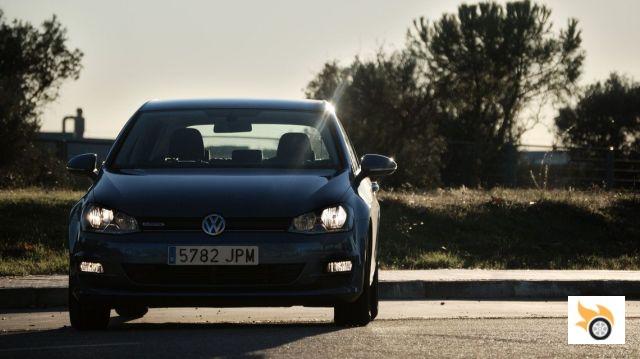
At 1,500 RPM and delivers a torque of 175 Nm, and at 2,000 RPM we have at our disposal the 200 Nm. It delivers the same power as the 1.4 Turbo of the previous generation Opel Astra, only that one declared 140 hp. It is also equal in power to the 1.2 TCe of the Renault Mégane and 132 hp. All this is according to the technical sheet, if it gives 130 hp in real bank I believe it. It doesn't ask to downshift compulsively, in fact, the lever has to be moved as little as in a petrol car. Diesel addicts, you can get rid of this one. Besides, this one goes past 6,000 RPM, although it's already a bit flat if you keep on rushing.
In my audio notes, under an obvious feeling of euphoria, I said that it has all the advantages of a three-cylinder and none of the disadvantages. I stand by what I said. The most susceptible will tell me that it has timing belts instead of chain, but they don't have a fixed maintenance interval, in Volkswagen they say when it's convenient to change them. It's the same with the service belts. This, at the end of the day, saves money.
It has the cool sound of a three-cylinder, but without the rattle. For example, I find it much better than the 1.0 EcoBoost in the Ford Focus, and it also consumes less fuel. What's more, this car is a real bargain, and in the test I didn't look for the lowest possible fuel consumption. The average was 5.5 l/100 km of petrol, 810 kilometres to the reserve (45 litres consumed), and I squeezed the tank until it showed 20 km remaining. Other on-board computers don't show such low figures so we don't rush. And it can do more when it reaches zero, it's 5 liters of reserve, but the range is 80 km when it jumps. I subsequently lowered it to 5 l/100 km real.
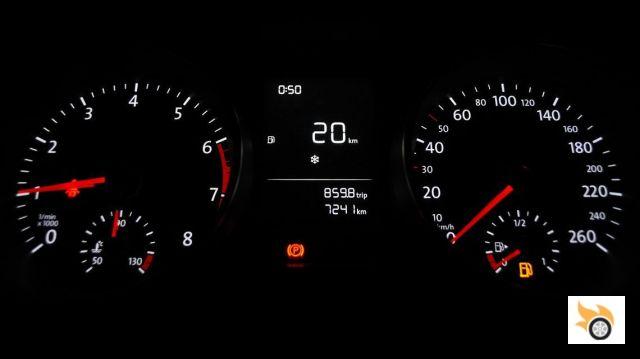
When I put all my efforts to spend little, I managed to reach 3.5 l/100 km (computer) from Fuenlabrada to Madrid, at an average of more than 50 km / h, that is, I was not stepping on eggs (in the whole test have been 63 km / h). The homologated consumption I've even managed to lower it, but with a full tank you have to have all the gods in our favor to do such a thing. The 5.5 l/100 km, which practically coincide with what the computer reported, have been achieved reaching 140 km / h and more than once. Of course, I was almost always alone and without a load.
Oddly enough, the efficiency monitor thinks my driving can improve a lot more :/
I haven't been able to check it, but I'd bet that on a long trip, driving very light, the fuel consumption is lower than in the 1.2 TSI and the 1.4 TSI, and the latter is an engine with an excellent balance between performance and consumption. In other words, it won't be the typical three-cylinder that when you take it out of its comfort zone starts to guzzle like a beast. Even in sporty driving it's fuel efficient, and the engineers have really done their best with the thermal management and the reduction of internal friction losses.
10 years ago, with a Mégane II 1.6 16v I didn't get such a low fuel consumption even with the limiter at 90 km/h. I only consider that a multipoint naturally aspirated is better in terms of pollution, this one needs a little plug in the ass to keep the damn particles out. But Volkswagen will eventually bring out the first TSI's with FAP this year. It's the best three cylinder engine I've ever tried, and believe me, I've tried a few. If they were all like this, I'd be much less angry about them.
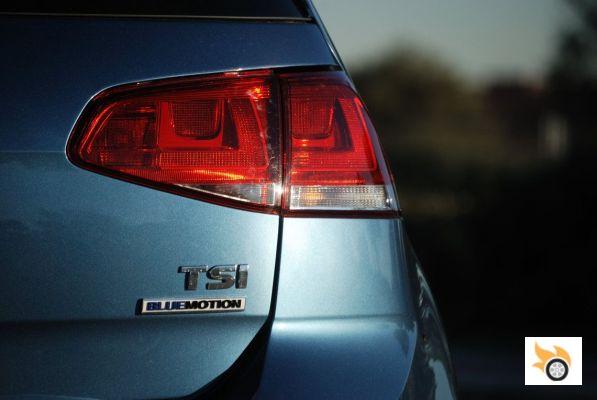
Conclusions
If I've been praising this car it has been with justice, it is a very good car, and its three-cylinder engine is one of the best in the market. It's not perfect by any means, there are much better equipped alternatives for the same money, or with a more fun/dynamic behaviour, like the Focus or the Kia cee'd, if my memory serves me correctly. On the other hand, this car has everything you need for everyday life. With optional extras things can be improved substantially, but you know, it's more money.
Buying a Golf means paying more, but I've already explained where those thousands of euros go. In the long term, I would say that the interior will age better than in some of its rivals, which after 150,000 km can already have a considerable amount of crickets and various noises. It's still one of the reference models in the market, so the most important things haven't changed in the restyling, and we're talking mostly about technological improvements. This engine, for example, is the same as in the updated model.
If this bodywork is not enough for us, nothing happens, you can also have a 1.0 TSI Bluemotion in the Sportsvan and Variant. The only thing missing is the option of an automatic, and it would be a rival to be taken into account with respect to the Toyota Auris Hybrid. By the way, the Japanese hybrid is very close in price to this Golf, which exceeds the minimum recommended retail price of 20,000 euros. Yes, for a three-cylinder it's a lot of money, but you have to consider the whole package.
